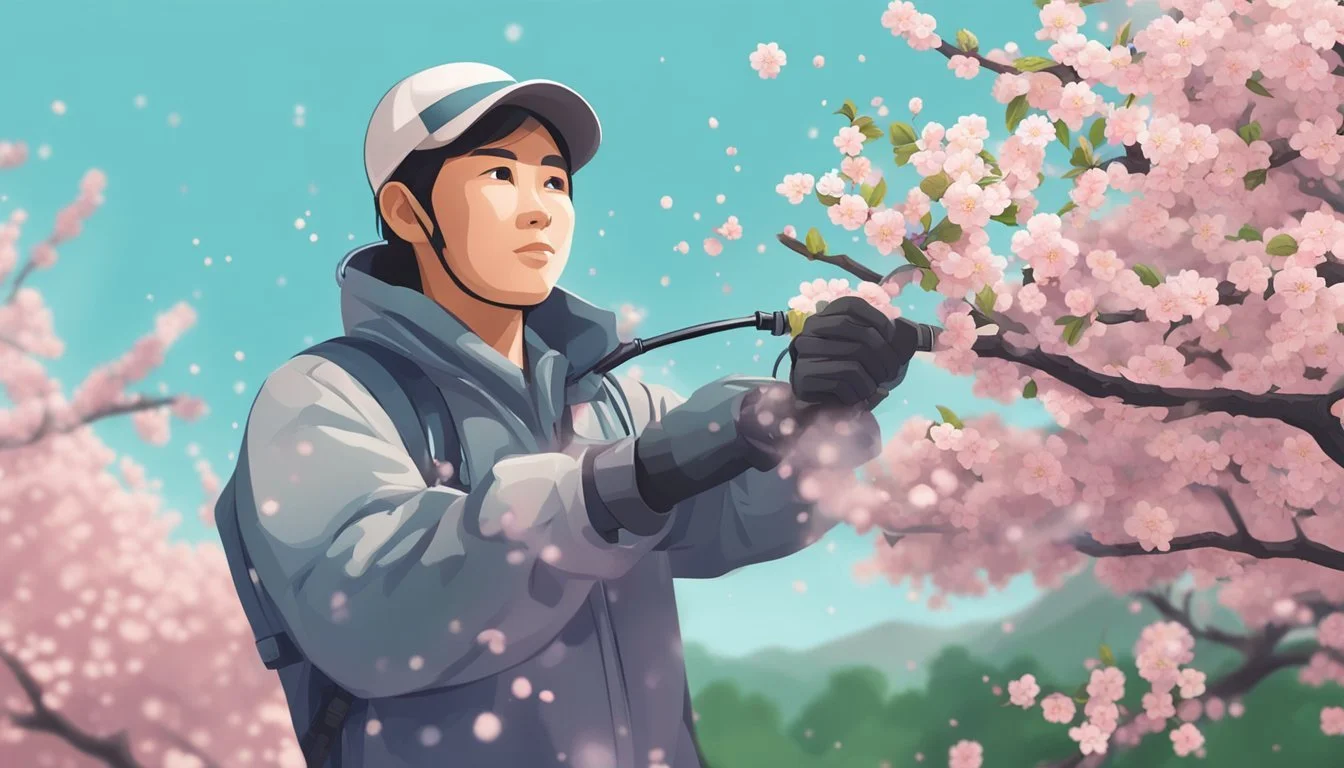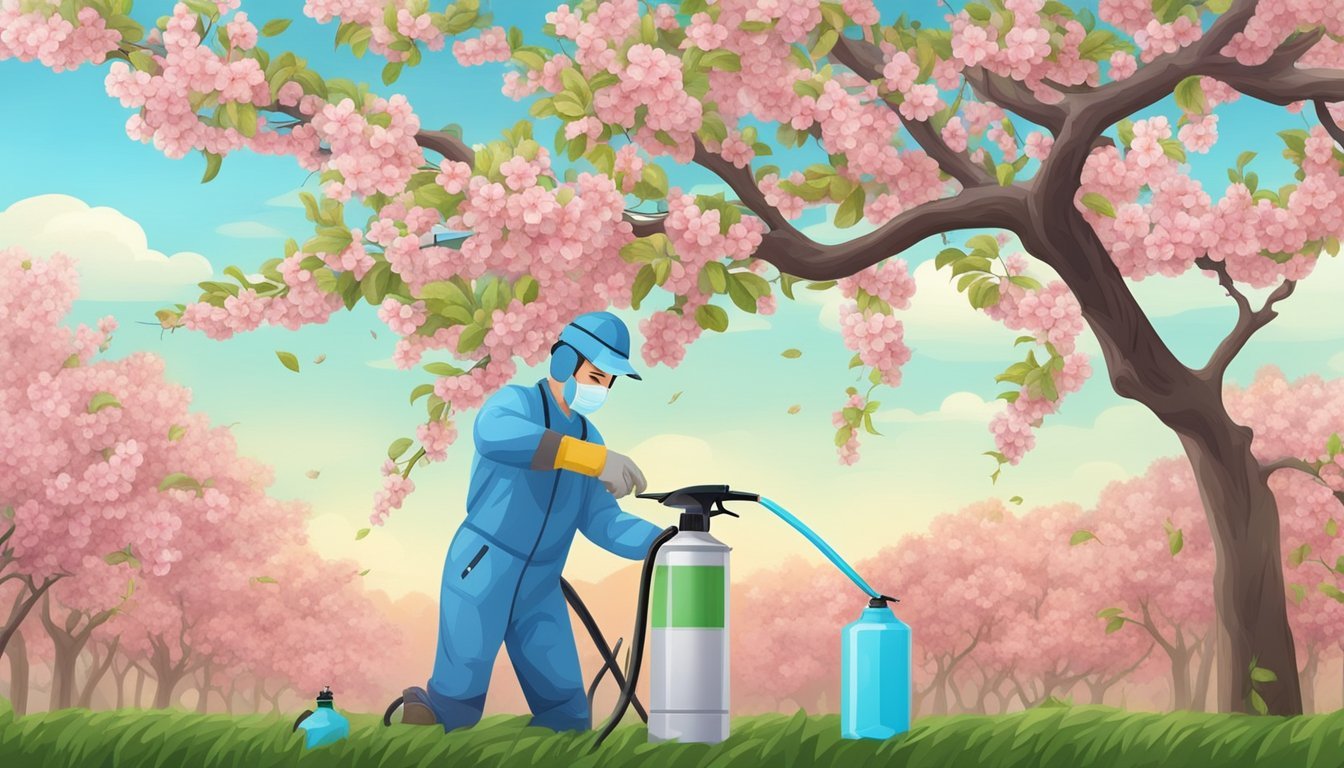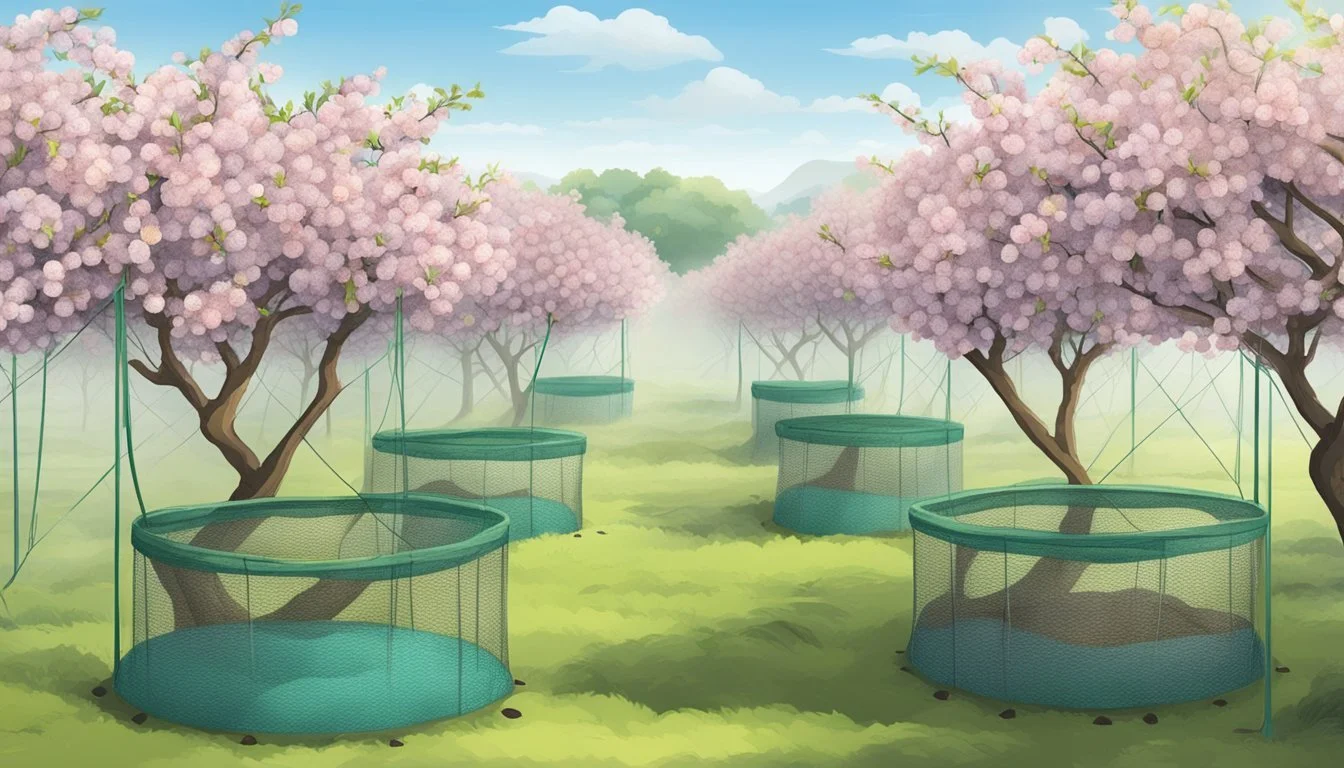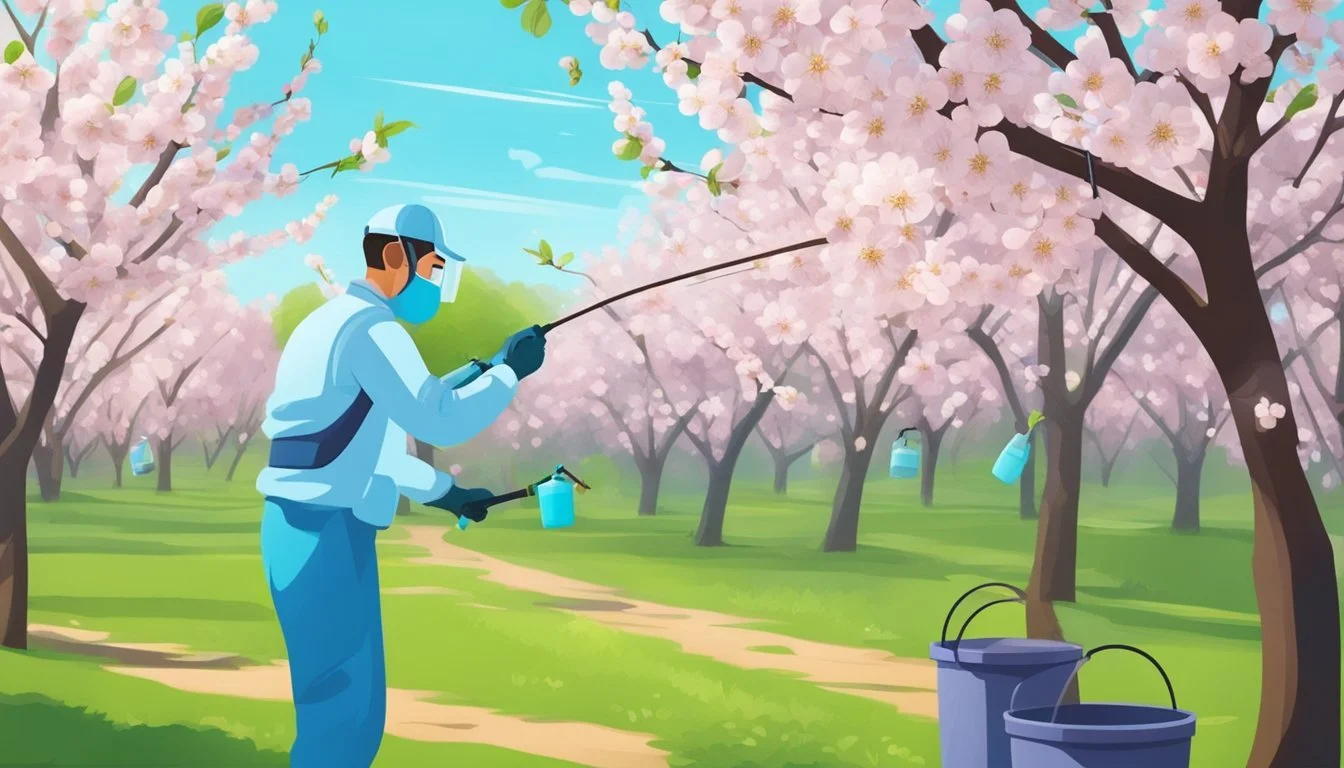Pest Control for Japanese Plum Trees
Effective Strategies and Solutions
Maintaining the health of Japanese plum trees involves recognizing and addressing the array of pests that can affect these fruiting trees. Unlike other fruit trees, Japanese plum trees have comparatively fewer pest issues, but the pests they do encounter can significantly hinder fruit production or even be lethal to the trees. Effective pest control for Japanese plum trees requires an understanding of the common threats and the implementation of management strategies to combat them.
Insect infestations can disrupt the growth and fruit yield of plum trees, and are often identified by the damage they leave on leaves, fruit, or the tree itself. The approach to controlling these pests ranges from preventative techniques, such as selecting disease-resistant varieties and conducting regular maintenance activities like pruning and weeding, to direct interventions including mechanical and chemical controls.
Ensuring your plum trees are closely monitored plays a crucial role in pest control. Early detection of issues allows for timely intervention, which can greatly reduce the impact of pests such as plum curculio, aphids, and Japanese beetles. Integrated pest management strategies can be employed that combine non-chemical methods, like shaking limbs to dislodge beetles, with targeted applications of insecticides during key times in the pests' life cycles to protect the trees' health and ensure successful fruit production.
Understanding Japanese Plum Trees
Japanese plum trees, also known as Prunus salicina, are sought after for their lush blooms and delicious fruit. In the United States, these trees are a popular choice for growers due to their adaptability and reward in the form of sweet plums.
Characteristics and Growth Habits
Japanese plum trees are deciduous and tend to have a vigorous growth pattern, often reaching heights of 15-20 feet. They flourish in full sun and require well-draining soil to prevent root rot. These trees generally start bearing fruit within 3-6 years after planting, with optimal productivity around their 8th to 12th year. They typically bloom early in the spring, with their fruit reaching maturity in the summer.
Common Diseases Affecting Plum Trees
Several diseases can impact Japanese plum trees:
Black knot, causing dark, swollen growths,
Brown rot, leading to fruit decay,
Leaf spot, which results in foliage blemishes.
Regular preventive care is vital, including proper pruning and applications of fungicide to manage these afflictions.
Beneficial Insects and Natural Predators
Beneficial insects play a crucial role in the health of plum trees. Predators like ladybugs and lacewings are invaluable in controlling aphids, while bees are essential pollinators for fruit production. Encouraging a diverse ecosystem contributes to natural pest control and can improve overall tree health.
By understanding the specific characteristics, diseases, and beneficial organisms associated with Japanese plum trees, growers can effectively cultivate and maintain these beautiful and fruitful trees.
Identifying Pest Problems
Early identification and intervention are key in managing pests that could harm Japanese plum trees. Recognizing common culprits and their indicative signs ensures the health and productivity of the trees.
Common Plum Tree Pests
Japanese plum trees are susceptible to a variety of pests, including:
Aphids: These small insects can cause foliage to curl and stunt growth.
Plum Curculio: This beetle is notorious for its larvae, which burrow into fruit.
Japanese Beetles: These pests feed on the leaves, leading to severe defoliation.
Scale Insects: They appear as small bumps on branches and stems, sapping the tree's strength.
Mites: Spider mites can create fine webs and cause leaves to appear speckled or discolored.
Knowing these pests is the first step in protecting your plum trees.
Signs of Pest Infestation
Monitoring a plum tree for pest activity involves looking for:
Foliage Damage: Chewed leaves or holes can indicate the presence of beetles or caterpillars.
Discoloration: A sign of mites or scale insects feeding on the sap.
Eggs or Larvae: Check the undersides of leaves and fruit for evidence of eggs or the grubs of plum curculio.
Sticky Residue: Aphids excrete a substance known as honeydew, which can attract other insects or lead to sooty mold.
If these signs are present, it's crucial to identify the specific pest to treat effectively.
Monitoring the Health of Plum Trees
Regular inspection of Japanese plum trees is essential. A healthy tree is better equipped to repel pests. This includes:
Visual Inspection: Regularly examine leaves, stems, and fruit for any signs of pests.
Preventive Measures: Implementing cultural practices such as proper watering, pruning, and cleanup can discourage pest colonization.
Professional Assessment: If signs of pests are found, it may be beneficial to consult with an expert to confirm the type of pest and the extent of infestation.
Pest Control Management Strategies
The management of pests in Japanese plum trees requires precise strategies that control infestations and prevent damage to the garden effectively. These strategies fall into several categories, including integrated pest management, cultural, biological, and chemical controls, each employing different techniques and products like insecticides and natural controls.
Integrated Pest Management (IPM)
Integrated Pest Management (IPM) involves monitoring pest populations and employing a combination of methods to keep pests below economically damaging levels. It emphasizes thorough planning and knowledge of pests and products. Gardeners must read product labels carefully and implement controls at optimal times for maximum effect.
Cultural Controls
Cultural controls focus on preventing pest problems through good garden hygiene and cultivation practices. This includes:
Regularly sanitizing tools to prevent the spread of disease.
Choosing disease-resistant plum tree varieties for planting.
Ensuring proper watering, fertilization, and pruning to keep trees healthy, thereby reducing their susceptibility to pests.
Biological Controls
Biological controls utilize natural predators and parasites to reduce pest populations. For instance, introducing beneficial insects that prey on common plum tree pests can be an effective natural control method. These controls are toxic-free and can maintain a balance in the garden's ecosystem.
Chemical Controls
Lastly, chemical controls utilize products like pesticides and insecticides for more severe pest issues. These include:
Dormant oils which can suffocate overwintering pests and are best applied when temperatures are between 45 and 55°F.
Insecticidal soaps and neem oil are less toxic options for managing pests during the growing season.
Specific insecticides, like Gardentech® Sevin® Concentrate Bug Killer, offer a broader spectrum of control and should be used with precision following the labels clearly to ensure effective and safe application.
Preventative Practices
Effective pest management in Japanese plum trees begins with preemptive actions that focus on creating a healthy growing environment and thwarting pest issues before they arise. Here, we will explore the foundational steps to minimize pest pressures through cultural practices.
Proper Planting and Site Selection
Selecting the appropriate site and planting correctly set the stage for a plum tree's health. They thrive in well-draining soil and need full sun exposure to promote optimal growth and reduce the likelihood of pest infestations. During early spring, ensure that trees are planted at the correct depth in soil with good air circulation to prevent stagnant moisture, which pests favor.
Routine Maintenance and Pruning
Maintaining a regular pruning schedule is crucial. Removing dead or infected branches during the dormant period, typically in late winter or early spring, prevents the spread of pests and diseases and supports healthy tree development. Consistent care during the growing season ensures better yield and quality at harvest. Pruning allows sunlight to penetrate the canopy and air to flow freely, reducing the potential for pest havens.
Soil Health and Nutrient Management
Soil provides the essential nutrients for plum trees, making soil health management paramount. Regularly test the soil to maintain the right balance of nutrients which bolsters a tree's health and resilience against pests. Providing adequate soil moisture, particularly during dry spells in the growing season, also plays a significant role. Organic mulches conserve moisture and improve soil structure, supporting the tree's vigor and making it less susceptible to pests.
Chemical Treatments and Application
Effective pest control in Japanese plum trees hinges on selecting the right chemicals and applying them at optimal times with correct techniques. This involves understanding pesticide labels and being strategic about application schedules.
Choosing the Right Pesticide
When selecting a pesticide for Japanese plum trees, it's important to consider the specific pests or diseases you are targeting. For instance, Monterey Fruit Tree Spray Plus is appropriate for various pests and diseases. Ferti-Lome® Broad Spectrum Landscape & Garden Fungicide can be used to prevent a range of fungal diseases, while Hi-Yield® Captan 50W Fungicide is another option for fungal control. For insect pests, Hi-Yield® Vegetable & Ornamental Insect Control may be applied. Always choose a pesticide registered for use on plum trees and effective against the intended pest or disease.
Understanding Pesticide Labels
Pesticide labels contain crucial information about the product, such as its active ingredients, concentration, and safety precautions. For example, labels will indicate whether a product is a ready-to-use spray or a concentrate that needs dilution. It is imperative to read labels carefully to adhere to dosage recommendations and avoid harming the tree or fruit production.
Application Timing and Techniques
Timing is critical when applying pesticides to plum trees. The growing season dictates application timing; for many pesticides, early spring is ideal, just before the blossom period. Effective techniques include thoroughly coating both sides of leaves and branches. Spraying should be consistent and methodical to ensure coverage. If using concentrate formulations, mix as directed on the label, typically in a sprayer. Remember to apply in calm weather to avoid drift and ensure the product remains on the target area.
Environmental Considerations
When managing pests in Japanese plum trees, it is crucial to consider the environmental impacts. Addressing these considerations is a balancing act that aims to protect pollinators, avoid soil and water contamination, and comply with local regulations.
Impacts on Pollinators and Wildlife
Pollinators play a vital role in the health of Japanese plum trees by facilitating pollination, which is essential for fruit production. However, certain pesticides can be toxic to these beneficial insects. It's imperative to choose pest control methods that minimize harm to bees and other wildlife, helping to maintain biodiversity in the garden.
Pesticide Runoff and Soil Contamination
Pesticides used for pest control can contribute to soil contamination and affect water quality through runoff. Responsible gardening practices involve selecting pesticides with a lower risk of contamination, timing the application to avoid heavy rainfall, and employing targeted application techniques to reduce runoff to adjacent lawns and water bodies.
Compliance with Local Regulations
Each region may have specific regulations regarding pesticide use in residential gardening and commercial agriculture. These rules aim to protect the environment and public health. Therefore, individuals are encouraged to research and comply with their local laws to ensure their pest control practices are both effective and legal.
Alternative Control Methods
When dealing with Japanese plum tree pests, there are several non-chemical methods to mitigate infestation. These strategies are often safer for the environment and can be equally effective when implemented correctly.
Organic Approaches
Organic pest control for Japanese plum trees can include the use of neem oil, a natural pesticide that is effective against various pests, including aphids and mites. It acts as an insect repellent, antifeedant, and egg-laying deterrent. Similarly, dormant oil can be applied during the dormant season to smother overwintering pest eggs and larvae. Insecticidal soap is another option, targeting soft-bodied insects like aphids, without harming beneficial insects when used appropriately.
Neem Oil: Apply as per the label instructions, typically at a concentration of 2%.
Dormant Oil: Use in the late winter or early spring before bud break.
Insecticidal Soap: Spray directly on pests; repeat application may be necessary.
Mechanical Barriers and Traps
Mechanical control methods include making use of barriers and traps. Tree banding with a sticky substance can prevent crawling pests from ascending the plum trees. There are various traps available, designed to attract and capture specific pests. For instance, pheromone traps lure and trap male insects, interrupting the mating cycle and reducing pest populations.
Sticky Bands: Place around the trunk to catch crawling insects.
Pheromone Traps: Deploy as per manufacturer's guidelines, usually in early spring.
Homemade Remedies
Simple homemade remedies such as soapy water can control minor infestations. This straightforward mixture can be used to knock down soft-bodied pests like aphids when they are observed on the foliage. However, it is a contact insecticide and must be applied directly to the pests. For a general boost in natural control, one can encourage beneficial insects like ladybugs and lacewings that feed on common pests.
Soapy Water Mixture: Mix 2 teaspoons of mild liquid soap with a quart of water and spray directly on pests.
Beneficial Insects: Attract them by planting companion plants like dill, fennel (how long does fennel last?), and marigold.
Seasonal Care for Plum Trees
Effective seasonal care for plum trees is essential to enhance fruit production and maintain tree health. This involves specific practices during spring, summer, and fall, each tailored to the tree’s growth cycle and pest control needs.
Spring and Pre-Bloom Care
In early spring, plum trees begin their growth cycle. Pruning is crucial as it removes dead or diseased wood and encourages healthy growth. Trees should be checked for signs of pests as certain, like Japanese beetles, can affect the plum trees early in the season. Fertilization is also important; a balanced fertilizer helps support the upcoming bloom and fruit development. Additionally, watering is key during dry spells, as adequate moisture is essential for fruit set.
Summer Maintenance and Pest Monitoring
During the summer, plum trees are in their active growth phase. Vigilant pest monitoring is crucial as it can prevent infestations from harming fruit production. As the fruits develop, thinning may be necessary to ensure larger, healthier plums at harvest. Properly spaced fruits reduce the risk of disease and allow for better sunlight exposure. Regular watering should continue, especially in periods of drought, to support the developing fruits and overall tree health.
Key Summer Tasks:
Monitor and control pests
Thin fruits
Ensure consistent watering
Fall Cleanup and Preparing for Dormancy
Once the harvest is complete, fall cleanup begins. Removing fallen fruit and leaves from around the tree can reduce disease and pest issues the following year. This is also the time to prepare the plum trees for dormancy. Post-harvest fertilization should be avoided as it can stimulate new growth that will be vulnerable to winter damage. Instead, focus on watering thoroughly before the first freeze, which helps trees withstand the cold. A layer of mulch can provide root insulation and moisture retention through the cooler months.
Key Fall Tasks:
Cleanup fallen debris
Cease fertilization
Water deeply before freeze
Mulch for insulation
Frequently Asked Questions
Effective pest management for Japanese plum trees involves timely interventions and understanding the lifecycle of common pests. These FAQs provide guidance on maintaining the health of your plum trees through informed decisions and practices.
How can I prevent bugs from infesting my plum trees?
Prevention of bug infestation in plum trees starts with selecting disease-resistant varieties and maintaining proper tree care routines, such as adequate watering, fertilizing, pruning, and cleanup to reduce the potential for pests.
What is the most effective treatment for plum tree pests?
The effectiveness of treatments depends on the specific pest, but a consistent spray schedule using horticultural oils or insecticides can prevent many issues before they emerge.
When should I spray my plum trees to protect against worms?
Spraying plum trees to protect against worms like plum curculio should be done when temperatures are between 45 and 55°F, avoiding strong sunlight and frost, to ensure the oil treatments dry properly without damaging the trees.
How do I control plum curculio in my fruit trees?
Controlling plum curculio involves thorough monitoring and using targeted insecticides during specific growth stages of the plum trees, as well as manual removal of the pests where applicable.
What are effective methods for managing Japanese beetles on plum trees?
For Japanese beetles, methods such as hand-picking or shaking them off the trees and into soapy water can be effective. Some may also recommend sprays or traps to manage beetle populations.
What causes holes in plum tree leaves, and how can I treat it?
Holes in plum tree leaves are commonly caused by insects like Japanese beetles or plum curculio. Control methods include physically removing the pests and applying appropriate pesticides if necessary. Regular inspection helps in early detection and management.








